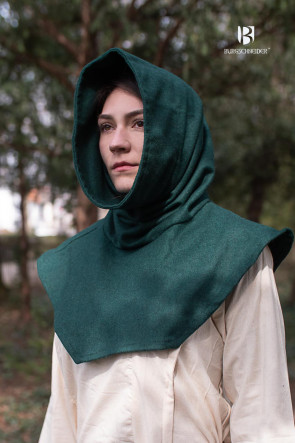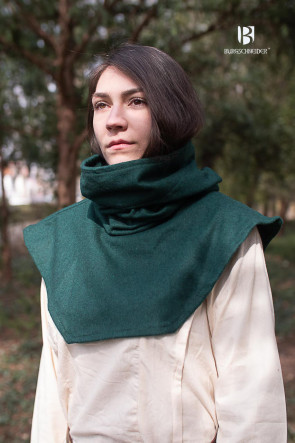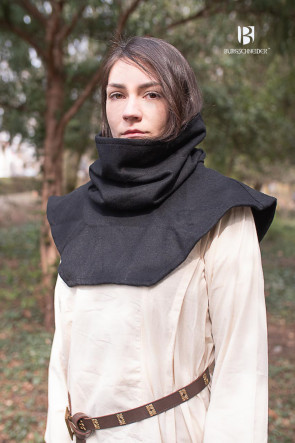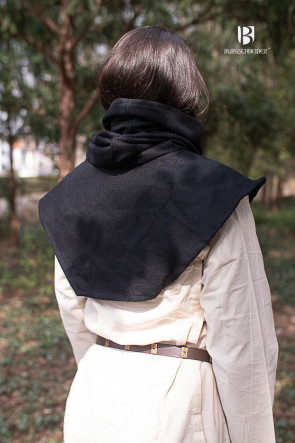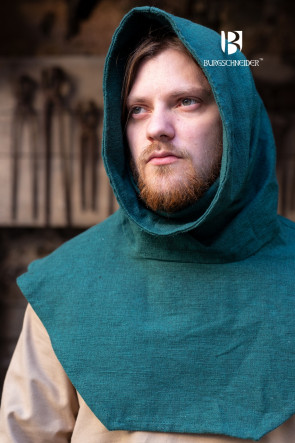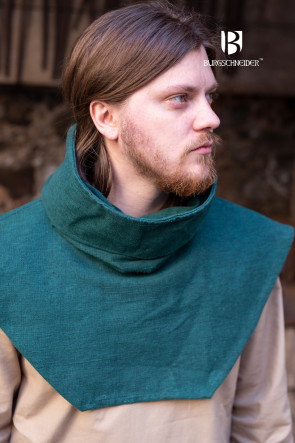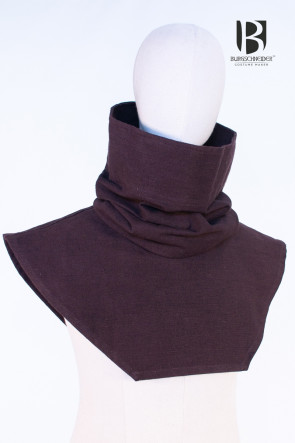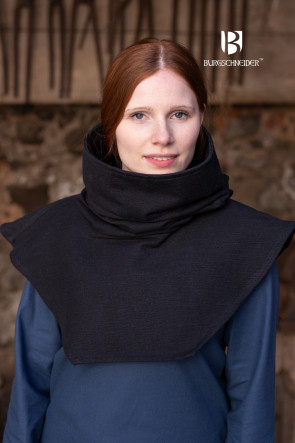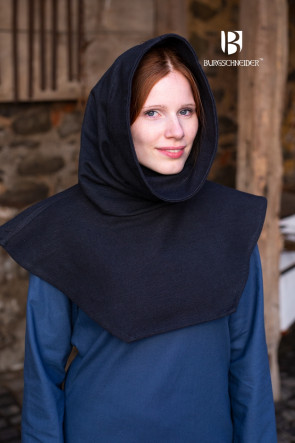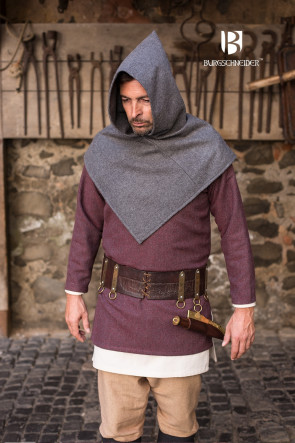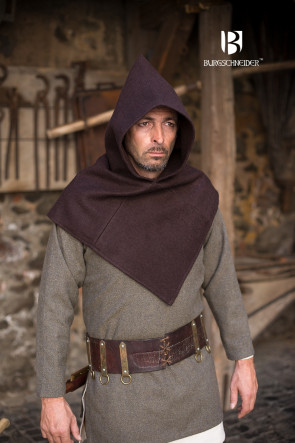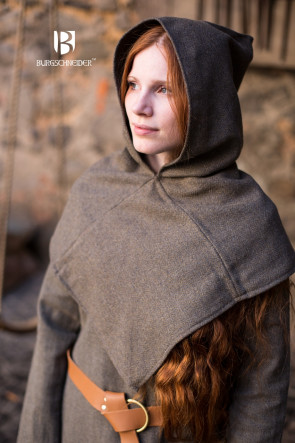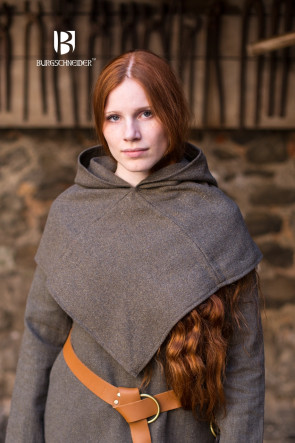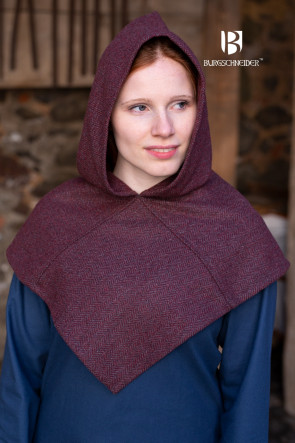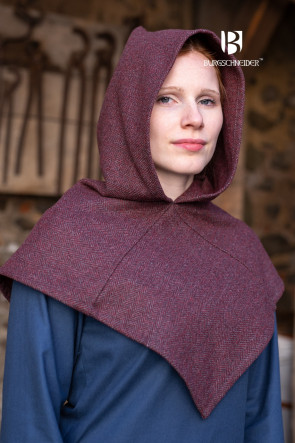Medieval Cowls
The cowl, also know as Gugel, was a pragmatic piece of clothing in the early middle ages to protect from wind and weather. The cowl wasn't pointed like in the high middle ages. Today on the reenactment events you can find a cowl with a long tip. The long tip was a fashion phenomenon of the high and late middle ages. The tip on the cowl is often called Sendelbinde. This name is not accurate respectively its scientific method of the 19. century as a result. A convincing demonstration you can find in Katrin Kanias Kleidung im Mittelalter: Materialien - Konstruktion - Nähtechnik. Ein Handbuch.
-
Tube Gugel Noah - Green
Made from wool felt, the Noah Hooded Cowl is an extremely versatile garment. It can be worn as a scarf, face cover or hood to help ward off the cold. The cowl is perfectly suitable for all genders and is a great option for LARP events or medieval festivals.
Learn More€29.90 -
Tube Gugel Noah - Black
Made from wool felt, the Noah Hooded Cowl is an extremely versatile garment. It can be worn as a scarf, face cover or hood to help ward off the cold. The cowl is perfectly suitable for all genders and is a great option for LARP events or medieval festivals.
Learn More€29.90 -
Tube Gugel Alex - Green
- Genre: Fantastic
- Sizes: S, M, L
- Product Details:
- Can be used as scarf, face guard and hood.
- Material:Devon Rough 100% Cotton
- The colours shown may differ from the actual colours depending on the monitor and resolution of your computer.
- Please note that cotton fabrics may shrink when washed!
€19.90 -
Tube Gugel Alex - Brown
- Genre: Fantastic
- Sizes: S, M, L
- Product Details:
- Can be used as scarf, face guard and hood.
- Material:Devon Rough 100% Cotton
- The colours shown may differ from the actual colours depending on the monitor and resolution of your computer.
- Please note that cotton fabrics may shrink when washed!
€19.90 -
Tube Gugel Alex - Black
- Genre: Fantastic
- Sizes: S, M, L
- Product Details:
- Can be used as scarf, face guard and hood.
- Material:Devon Rough 100% Cotton
- The colours shown may differ from the actual colours depending on the monitor and resolution of your computer.
- Please note that cotton fabrics may shrink when washed!
€19.90 -
Skjoldehamn Wool Cowl Bjorn - Grey
The Skjoldehamn Cowl was discovered in a pagan grave from the first half of the 11th century. This is one of the first examples of the headgear "Gugel" itself.
The hood has a basic square shape, characteristically the wide brim ends with a corner on the chest.
The grave find from Skjoldehamn raised many questions since its recovery in 1936 and still occupies today. According to current research, the dating of the pagan grave in the marshland is the first half of the 11th century. The hood of the gugel from Skjoldehamn has a simple square basic shape and a very wide brim, which does not fall round, but with a corner on the chest. This gugel is also a very early example of the type of headgear that became a ubiquitous garment in Europe during the Middle Ages.
In the course of research, attempts were made to assign the garment to a gender and cultural group. For this purpose, not only the DNA of the buried person was examined more closely, but also the additional finds. The enclosed trousers determined the theory of the researchers that the person must have been male. DNA examination in 1999 showed no Y chromosome present in the bones, which supported the theory that it had to be a woman instead. However, this methodology is considered outdated.
The question of culture points to Norway. This is assumed by ornamentation and morphological features, which suggest that the buried person was a Sami tribal member. Further research is needed, as some key evidence for these hypotheses is still lacking. More modern DNA analysis and research into the history of the fashions of the various Sami groups will shed light on this.
Learn More€29.90 -
Skjoldehamn Wool Cowl Bjorn - Brown
The Skjoldehamn Cowl was discovered in a pagan grave from the first half of the 11th century. This is one of the first examples of the headgear "Gugel" itself.
The hood has a basic square shape, characteristically the wide brim ends with a corner on the chest.
The grave find from Skjoldehamn raised many questions since its recovery in 1936 and still occupies today. According to current research, the dating of the pagan grave in the marshland is the first half of the 11th century. The hood of the gugel from Skjoldehamn has a simple square basic shape and a very wide brim, which does not fall round, but with a corner on the chest. This gugel is also a very early example of the type of headgear that became a ubiquitous garment in Europe during the Middle Ages.
In the course of research, attempts were made to assign the garment to a gender and cultural group. For this purpose, not only the DNA of the buried person was examined more closely, but also the additional finds. The enclosed trousers determined the theory of the researchers that the person must have been male. DNA examination in 1999 showed no Y chromosome present in the bones, which supported the theory that it had to be a woman instead. However, this methodology is considered outdated.
The question of culture points to Norway. This is assumed by ornamentation and morphological features, which suggest that the buried person was a Sami tribal member. Further research is needed, as some key evidence for these hypotheses is still lacking. More modern DNA analysis and research into the history of the fashions of the various Sami groups will shed light on this.
Learn More€29.90 -
Skjoldehamn Wool Cowl Bjorn - Autumn Green
The Skjoldehamn Cowl was discovered in a pagan grave from the first half of the 11th century. This is one of the first examples of the headgear "Gugel" itself.
The hood has a basic square shape, characteristically the wide brim ends with a corner on the chest.
The grave find from Skjoldehamn raised many questions since its recovery in 1936 and still occupies today. According to current research, the dating of the pagan grave in the marshland is the first half of the 11th century. The hood of the gugel from Skjoldehamn has a simple square basic shape and a very wide brim, which does not fall round, but with a corner on the chest. This gugel is also a very early example of the type of headgear that became a ubiquitous garment in Europe during the Middle Ages.
In the course of research, attempts were made to assign the garment to a gender and cultural group. For this purpose, not only the DNA of the buried person was examined more closely, but also the additional finds. The enclosed trousers determined the theory of the researchers that the person must have been male. DNA examination in 1999 showed no Y chromosome present in the bones, which supported the theory that it had to be a woman instead. However, this methodology is considered outdated.
The question of culture points to Norway. This is assumed by ornamentation and morphological features, which suggest that the buried person was a Sami tribal member. Further research is needed, as some key evidence for these hypotheses is still lacking. More modern DNA analysis and research into the history of the fashions of the various Sami groups will shed light on this.
Learn More€29.90 -
Skjoldehamn Gugel Knud Herringbone - Olive/Grey
The Skjoldehamn Cowl was discovered in a pagan grave from the first half of the 11th century. This is one of the first examples of the headgear "Gugel" itself.
Learn More
The hood has a basic square shape, characteristically the wide brim ends with a corner on the chest.
The grave find from Skjoldehamn raised many questions since its recovery in 1936 and still occupies today. According to current research, the dating of the pagan grave in the marshland is the first half of the 11th century. The hood of the gugel from Skjoldehamn has a simple square basic shape and a very wide brim which does not fall round but with a corner on the chest. This gugel is also a very early example of the type of headgear that became a ubiquitous garment in Europe during the Middle Ages.
In the course of research, attempts were made to assign the garment to a gender and cultural group. For this purpose, not only the DNA of the buried person was examined more closely but also the additional finds. The enclosed trousers determined the theory of the researchers that the person must have been male. DNA examination in 1999 showed no Y chromosome present in the bones which supported the theory that it had to be a woman instead. However, this methodology is considered outdated.
The question of culture points to Norway. This is assumed by ornamentation and morphological features which suggest that the buried person was a Sami tribal member. Further research is needed, as some key evidence for these hypotheses is still lacking. More modern DNA analysis and research into the history of the fashions of the various Sami groups will shed light on this.€34.90 -
Skjoldehamn Gugel Knud Herringbone - Burgundy/Grey
The Skjoldehamn Cowl was discovered in a pagan grave from the first half of the 11th century. This is one of the first examples of the headgear "Gugel" itself.
Learn More
The hood has a basic square shape, characteristically the wide brim ends with a corner on the chest.
The grave find from Skjoldehamn raised many questions since its recovery in 1936 and still occupies today. According to current research, the dating of the pagan grave in the marshland is the first half of the 11th century. The hood of the gugel from Skjoldehamn has a simple square basic shape and a very wide brim which does not fall round but with a corner on the chest. This gugel is also a very early example of the type of headgear that became a ubiquitous garment in Europe during the Middle Ages.
In the course of research, attempts were made to assign the garment to a gender and cultural group. For this purpose, not only the DNA of the buried person was examined more closely but also the additional finds. The enclosed trousers determined the theory of the researchers that the person must have been male. DNA examination in 1999 showed no Y chromosome present in the bones which supported the theory that it had to be a woman instead. However, this methodology is considered outdated.
The question of culture points to Norway. This is assumed by ornamentation and morphological features which suggest that the buried person was a Sami tribal member. Further research is needed, as some key evidence for these hypotheses is still lacking. More modern DNA analysis and research into the history of the fashions of the various Sami groups will shed light on this.€34.90







